WALLEYE

SAUGEYE

SAUGER

Members of the perch family (Percidae), native sauger and introduced walleye and saugeye inhabit many of Oklahoma's water bodies. Often referred to as the best tasting freshwater fish, these toothy critters offer a delicious challenge to anglers.
Unique for their needle like teeth, these fish truly standout amongst Oklahoma's fish species.
Due to the peculiar light-gathering structure of their eyes, walleye seek deep water during the day to avoid the bright sun, feeding mostly at night. Saugeye and sauger can also be light sensitive and tend to be most active in shallow water in the low-light and overnight hours.
SPECIES PROFILE
- Oklahoma Distribution
Statewide in most large lakes and river systems.
- Description
Distribution originated from introductions made during the early 1950s in Canton and Tenkiller lakes. Since that time, adult walleye have been trapped (primarily from Canton Lake), their eggs taken by hand stripping, fertilized, and hatched in state fish hatcheries. Most major lakes in Oklahoma have been stocked. The best populations are in the western half of the state.
The first saugeye stocking in Oklahoma was in Lake Thunderbird in May 1985. Since this initial stocking, many other state lakes have been stocked with saugeye, for example, Atoka, Bluestem, Burtschi, Carl Blackwell, Ellsworth, Fort Cobb, Great Salt Plains, Hall, Holdenville, Jean Neustadt, Lawtonka, Shawnee Lakes, Sooner, Tom Steed, Vanderwork, and Waurika.
Sauger are found in the Arkansas, Poteau, Illinois, Red and Neosho watersheds and in several lakes and reservoirs around the state.
Walleye, saugeye and sauger are the largest fish in family Percidae.
To identify them, first look at the spiny dorsal fin. The walleye will have no spots on this fin; the sauger will have distinct spots; and the hybrid of the two species, the saugeye, will have spots and bars in the webbing of its spiny dorsal fin. The color of the fish and the presence or absence of the cheek scales may also help identify the difference.
- Habitat
Walleye and saugeye tend to congregate near the bottom on sand bars or near ledges and drop-offs.
Sauger are primarily a river and stream fish preferring the clear eastern river. It is not abundant anywhere and seems to be rare in the tailwaters below Lake Texoma.
- Natural Food Sources
- Insects
- Larvae
- Nightcrawlers
- Crayfish
- Snails
- Leeches
- Small Fish
- Spawning
Walleye spawn in early March when water temperatures reach 45°F to 50°F. Some 25,000 to 50,000 eggs per pound of body weight are produced each year by a single female. Fertilization occurs when eggs from the female and milt from the male are released simultaneously. Eggs fall between crevices in rock "rip-rap" along dams.
Saugeye are produced within our state fish hatcheries. Female walleye are crossed with male sauger resulting in a hybrid known as saugeye. Although not sterile, saugeye must be stocked routinely in order to maintain fishable populations.
The sauger is a spring spawner, but little is known about its biology in Oklahoma. Spawning occurs at night and is completed within two weeks, eggs are scattered over a firm substrate by females, with multiple males attending each female. No nest is constructed and no parental care is provided.
- Fish Facts
- Although walleye are not easy to catch, they are definitely worth the effort. Walleye filet is considered by gourmets to be among the best table fare.
- Trolling with deep-diving crankbaits along shoreline drop-offs is a good method for locating fish. Once one is caught, work the area thoroughly with crankbaits, jigs or jig-and-minnow combinations. Tailwater fishing also can be productive, especially during periods of heavy flow.
- Saugeye make first-class table fare. They are being stocked particularly in lakes with stunted crappie because once they reach 16 inches, they begin to feed on these fish, thus improving the crappie fishery. Anglers can look forward to bigger and better saugeye fishing throughout the state.
- In March and April, walleye move up onto rocky substrate to spawn. In many lakes, the preferred spawning habitats are rip-rap along dams and bridges. Jigs are excellent bait choices. Once spawning is complete, fish move to deeper water in main-lake areas. Trolling with deep-diving crankbaits along shoreline drop-offs is a good method for locating fish. Once one is caught, work the area thoroughly with crankbaits, jigs, or jig-and-minnow combinations. Tailwater fishing also can be productive, especially during periods of heavy flow.
- Other tips to keep in mind when walleye and saugeye fishing include:
- Avid walleye anglers should check out Waurika Lake. Using stick baits and jig and grub combinations along the rip-rap of the dam is very productive in late February and March. Walleye up to nine pounds have shown up in recent electrofishing surveys.
- Try fishing for walleye from the rip-rap at Lake Hefner during the months of March and November. These are the most productive times for walleye anglers in this lake.
- Legal-sized saugeye (>14”) are often caught during the winter at Lake Thunderbird. The best time is from dusk until about two hours after sunset. Try using a shallow-running minnow bait retrieved very slowly.
- Saugeye have rejuvenated fishing at lakes Ft. Cobb, Tom Steed, and Lawtonka - all historically prime walleye waters. Recent netting samples confirmed that saugeye numbers now rival peak walleye abundances in the “heydays” at each of these lakes.
- Anglers desiring to catch both hybrid striped bass and saugeye in the same lake should plan a visit to lakes Carl Blackwell and Sooner. Both lakes have abundant populations of both species and high percentages of large fish.
FISHING TIPS
Walleye spawn in water 45˚F to 50˚F which makes them vulnerable to anglers willing to brave the chilly outside temperatures in February and March, but the rewards are worth it.
As a general rule of thumb, the peak spawn typically lasts several days to several weeks in a given body of water and happens earlier in rivers than in lakes, in shallower lakes than in deeper lakes, in smaller lakes than in larger lakes and in poor water clarity lakes than in clearer lakes.
Walleye spawn over rock, rubble, gravel and similar hard structure in rivers and windswept lake shores in water one to six feet deep, where current clears away fine sediment and will cleanse and aerate the eggs.
There will be a lull following the spawn lasting from a few days to a couple weeks depending on the fish and water body. Once the fish recover the post-spawn bite can be more prolific than during the spawning period.
Walleye and saugeye like hard structure transition areas (areas of rapid depth change) near windswept shorelines and points for most of the year.
They will retreat to deep main lake humps and structure in the summer months as they are a cold-water species most comfortable in water between 55˚F to 75˚F.
Walleye and saugeye like long, slender lipped crankbaits as well as grubs, swimbaits and ring worms in shades of white, purple, chartreuse, orange or pink.
They will take an array of live bait (nightcrawlers, leeches and minnows being the most popular).
The most important factor to catching these unique looking fish is maintaining contact with the bottom. Once your bait gets above three feet off the bottom your chance for bites goes down.
If there are a lot of bottom snags while using a lipped crankbait, remove all the treble hooks from the bait and just replace the back hook with a medium-sized straight shank single point hook. This allows you to bang the crankbait into and across the bottom without snagging as easily.
The slower the retrieve speed the better for any walleye or saugeye presentation.
Crankbaits in tiger perch patterns or that have purplish backs are favorites among the toothy fish anglers. 2" to 4" grubs and swimbaits in shades of white, chartreuse, blue, purple, pink or orange are favored by those targeting saugeye and sauger.
Monkey Milk (white with black flakes) is a good color for saugeye in shallow water during the spring. Look for areas where peak crappie spawning is occurring and cast a 3" grub or swimbait in Monkey Milk along the shoreline during the hours around dawn and dusk.
If using natural bait, try a pre-packaged bottom bouncing setup like a Lindy rig or make your own using a non-snag weight, barrel swivel, 12- to 18-inch leader and small- to medium-sized bait holding hook paired with natural bait.
VIDEO HOW-TO TIPS FROM THE PROS
WRITTEN HOW-TO TIPS FROM THE PROS
Habitat to Target
- Rocky shoreline: the windswept sides of the lake along the dam, points, bays, coves and marinas in the low-light and overnight hours.
- Drop-offs & Ledges: areas of rapid depth change such as channel breaks, off-shore humps, points and dam.
- Grass flats: deep or shallow sandy areas that have abundant grass.
Rod/Reel Setup
- Medium to Medium-Heavy rod
- Spincasting, spinning or baitcasting reel
- 8-pound to 12-pound test line; heavy leaders over 12-pound test line or wire leaders help with line abrasion from bottom structure and the fish's sharp teeth.
Top Lures
- Lipless Crankbait
2" to 4" lipless crankbait in shades of white, chartreuse, orange, purple or pink
- Editor's pick: 3" Cotton Cordell Super Spot in Royal Shad
Image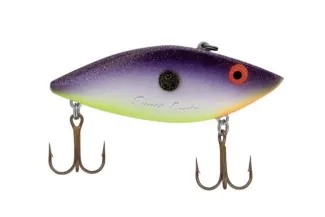
- Lipped Crankbait
3" to 5" lipped crankbait in shades of white, chartreuse, orange, purple or pink
- Editor's pick: 4-3/4" Bandit Lures Walleye Deep in Blue Shiner, Plasma or Sun Spot
Image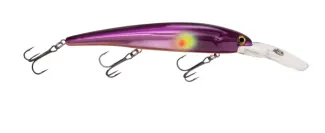
- Jerkbait
3" to 5" jerkbait in shades of white, chartreuse, orange, purple or pink
- Editor's pick: Bandit B-Shad in Popsicle or Orange Crush
Image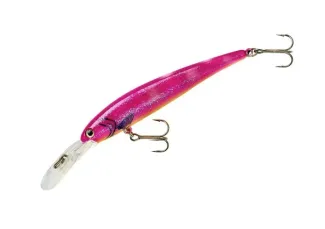
- Curly Tail Grub
2" to 5" curly tail grub in shades of white, chartreuse, orange, purple or pink
- Editor's pick: 3" Zoom Fat Albert in June Bug or Cotton Candy paired with a 1/8th to 1/2 ounce jig-head.
Image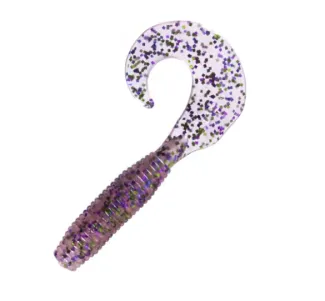
- Ring Worm
3" to 5" ringworm in shades of white, chartreuse, orange, purple or pink
- Editor's pick: 4" Mister Twister Ringworm in Purple Pink, Chartreuse/Orange Core or Purple Chartreuse Tail paired with a 1/8th to 1/2 ounce jig-head.
Image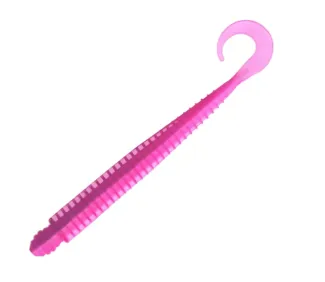
- Spinner Rig
Bottom bouncing harness spinners
- Editor's pick: Lindy Colorado Blade Crawler Harness (#3 blade) in Purple Smelt paired with a live nightcrawler
Image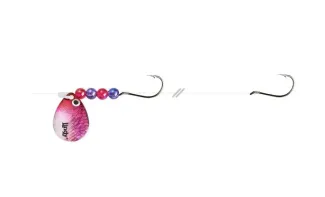
- Swimbait
2" to 5" swimbait in shades of white, chartreuse, orange, purple or pink
- Editor's pick: 4" Mister Twister Tri-Com Sassy Swimmer in Purple Pink or Chartreuse/Orange Core paired with a 1/8th to 1/2 ounce jig-head.
Image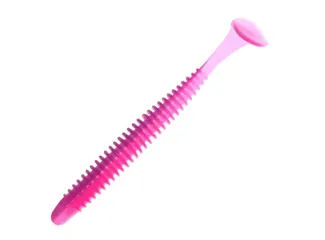
Top Bait
- Nightcrawler
Canadian nightcrawlers are one of the largest commonly available worms. They are sometimes called "dew worms" because they are sometimes found outside in the early morning when there is morning dew still on the ground and nearby plants. The scientific name for them is Lumbricus terrestris. Other names include "lobworm" or just "nightcrawlers." Despite the name, Canadian nightcrawlers are believed to have originated in Europe.
Image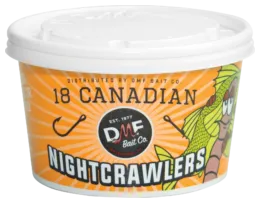
- Minnow
A bucket of minnows from a bait store (typically fathead minnows) or freshly netted shad are the preferred live bait choice of walleye anglers. Use minnows or shad in the 2-inch to 4-inch size range hooked on a jig-head or bottom bouncing rig.
Image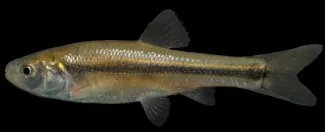 Image
Image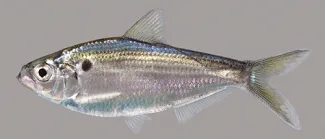
- Leech
Live or preserved leech hooked on a jig-head or bottom bouncing rig.
Image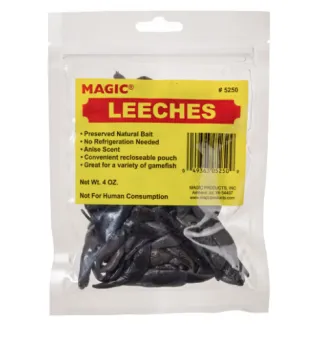
CLEANING TIPS
COOKING TIPS





